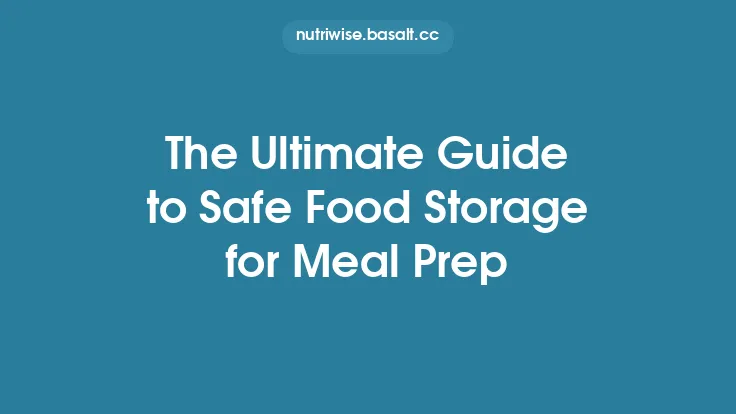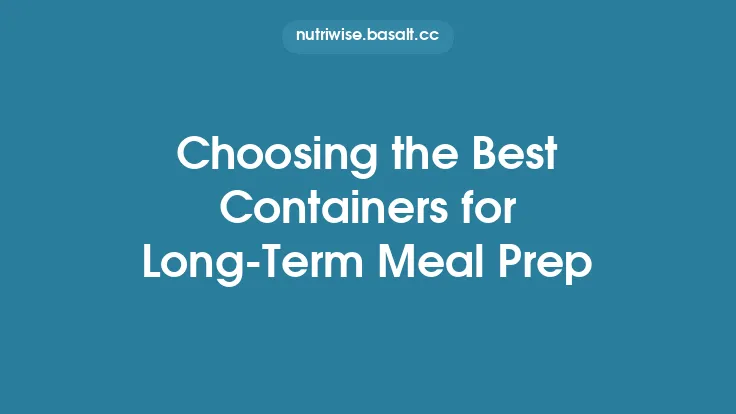Reusable containers have become a cornerstone of sustainable kitchens, offering a practical alternative to single‑use plastics while helping households cut waste, save money, and protect food quality. Selecting the right containers, however, involves more than simply picking the most popular brand. Material composition, seal integrity, thermal performance, durability, and end‑of‑life options all play a role in determining how “green” a container truly is. This guide walks you through the key considerations, technical details, and practical tips for choosing reusable containers that align with an eco‑friendly lifestyle.
Understanding Material Options
Glass
Glass is often celebrated for its inert nature—food does not leach into or out of the container, and the material is 100 % recyclable without loss of quality. When evaluating glass containers, consider:
- Tempered vs. annealed – Tempered glass can withstand sudden temperature changes (e.g., moving from freezer to microwave) and is less likely to shatter under impact. Annealed glass is more prone to breakage under thermal shock.
- Lid composition – Many glass jars pair with plastic, silicone, or metal lids. For a fully recyclable system, look for metal lids with a silicone gasket or lids made from high‑density polyethylene (HDPE) that can be recycled separately.
- Weight and ergonomics – Heavier glass can be a drawback for on‑the‑go meals. Some manufacturers offer reinforced glass with a thinner profile that still meets safety standards.
Stainless Steel
Stainless steel containers are prized for durability, resistance to corrosion, and excellent barrier properties against light and oxygen.
- Grade matters – Food‑grade 18/8 (304) stainless steel is the most common, offering a good balance of corrosion resistance and cost. Higher grades (e.g., 316) provide extra resistance to acidic foods but are typically more expensive.
- Insulation – Double‑wall vacuum‑insulated models keep food hot for up to 12 hours or cold for 24 hours, reducing the need for separate heating or cooling appliances.
- Lid sealing – Look for containers with a silicone gasket and a locking mechanism that creates a pressure‑tight seal, preventing leaks and extending shelf life.
BPA‑Free Plastics
Modern reusable plastics can be a viable option when weight, flexibility, and cost are priorities, provided they meet safety standards.
- Polypropylene (PP, #5) – High melting point (≈ 160 °C) makes it microwave‑safe and resistant to warping. It is also widely recyclable.
- Polyethylene terephthalate (PET, #1) – Often used for single‑use bottles, PET can be repurposed for reusable containers if it meets durability criteria. Look for “recycled PET” (rPET) to close the material loop.
- Polycarbonate alternatives – Some manufacturers use Tritan™ or Eastman Tritan™ copolyester, which are BPA‑free, clear, and impact‑resistant. Verify that the product is certified food‑safe and recyclable in your local stream.
Silicone
Silicone containers combine flexibility with heat resistance, making them suitable for both freezer storage and microwave reheating.
- Food‑grade silicone – Must meet FDA or EU food‑contact regulations (e.g., FDA 21 CFR 177.2600). Look for “food‑grade, platinum‑cured” silicone, which is more stable than peroxide‑cured variants.
- Durability – High‑quality silicone can endure thousands of temperature cycles without degradation, but it is less rigid than glass or steel, which may affect stacking efficiency.
Evaluating Seal Performance
A container’s seal determines how well it protects food from moisture loss, oxidation, and contamination. When comparing products:
- Gasket material – Silicone gaskets provide a flexible, airtight seal. Ensure the gasket is replaceable; over time, it can harden or tear.
- Locking mechanism – Snap‑fit lids are convenient but may not be as leak‑proof as screw‑on or clamp‑type closures. For liquids, a screw‑on lid with a torque‑controlled thread (e.g., 1.5 Nm) offers superior sealing.
- Pressure‑release feature – Some vacuum‑seal containers include a valve that releases excess pressure during heating, preventing lid blow‑outs.
Thermal Considerations
Choosing containers that can handle the temperature range you need reduces reliance on disposable alternatives.
| Material | Freezer Safe? | Microwave Safe? | Oven Safe? |
|---|---|---|---|
| Tempered Glass | ✅ | ✅ (no metal lids) | ❌ (unless specifically labeled) |
| Stainless Steel (single wall) | ✅ | ❌ (metal) | ❌ |
| Stainless Steel (double wall, insulated) | ✅ | ❌ (metal) | ❌ |
| PP Plastic | ✅ | ✅ | ❌ |
| PET (rPET) | ✅ (short‑term) | ✅ (short‑term) | ❌ |
| Silicone | ✅ | ✅ | ✅ (up to 230 °C) |
When you need to transition from freezer to microwave, a container that tolerates both extremes (e.g., tempered glass with a plastic or silicone lid) eliminates the need for transferring food to a different vessel.
Lifecycle Assessment (LCA) Basics
A true “green” choice considers the entire lifecycle—from raw material extraction to end‑of‑life disposal.
- Production energy – Stainless steel and glass have higher embodied energy than plastics, but they also have longer usable lifespans. A stainless steel container that lasts 10 years typically offsets its higher production impact compared to a plastic container that needs replacement after 2 years.
- Transport weight – Heavier containers increase carbon emissions during shipping. If you purchase locally‑manufactured items or bulk‑order to reduce packaging, you can mitigate this factor.
- Recyclability – Glass and stainless steel are infinitely recyclable without loss of quality. For plastics, prioritize #1 (PET) and #5 (PP) because they have well‑established recycling streams. Verify that your municipality accepts the specific plastic type.
- End‑of‑life options – Some manufacturers offer take‑back programs for stainless steel or silicone products, ensuring they are re‑melted or repurposed rather than landfilled.
Cost‑Benefit Analysis
While upfront costs for glass or stainless steel can be higher, a simple cost‑per‑use calculation clarifies the long‑term savings.
- Determine lifespan – Estimate the number of uses before the container shows signs of wear (e.g., 1,000 uses for a high‑quality stainless steel lunchbox).
- Calculate cost per use – Divide purchase price by estimated uses. A $30 stainless steel container used 1,000 times costs $0.03 per use, compared to a $5 plastic container that lasts 100 uses ($0.05 per use).
- Factor in waste disposal – Adding a modest landfill fee (e.g., $0.10 per kilogram) for disposable containers can tip the economic balance further toward reusable options.
Cleaning and Maintenance Best Practices
Proper care extends container life and maintains food safety.
- Dishwasher compatibility – Most tempered glass and stainless steel containers are dishwasher‑safe, but high‑heat cycles can degrade silicone gaskets over time. Remove gaskets before washing and place them on the top rack.
- Stain and odor removal – For stubborn odors in plastic or silicone, a soak in a solution of 1 part white vinegar to 4 parts water for 30 minutes, followed by a rinse, is effective. Baking soda paste works well for glass.
- Avoid abrasive tools – Metal scouring pads can scratch glass and stainless steel, compromising seal integrity. Use non‑abrasive sponges or soft brushes.
- Inspect regularly – Look for micro‑cracks in glass, dents in stainless steel, or warping in plastic. Replace compromised containers promptly to avoid contamination.
Matching Containers to Food Types
Different foods pose distinct challenges for storage.
| Food Category | Recommended Material | Reasoning |
|---|---|---|
| Acidic (tomatoes, citrus) | Glass, stainless steel (with non‑reactive interior) | Prevents leaching and corrosion |
| High‑fat (butter, oils) | Glass or stainless steel with airtight silicone gasket | Provides barrier against oxidation |
| Wet or liquid (soups, sauces) | Tempered glass with screw‑on lid or insulated stainless steel with leak‑proof lock | Prevents spills and maintains temperature |
| Granular (rice, beans) | Airtight PP containers with snap‑fit lids | Light weight, easy stacking |
| Frozen meals | Glass or silicone containers rated for freezer use | Avoids freezer burn and maintains shape |
Eco‑Label Verification
When shopping, look for credible certifications that confirm environmental claims:
- ISO 14001 – Indicates the manufacturer follows an environmental management system.
- BPI (Bottled Plastic Initiative) Recycled Content – Shows a percentage of post‑consumer recycled plastic.
- NSF/ANSI 61 – Confirms safety for food contact materials.
- Forest Stewardship Council (FSC) for wooden lids – Guarantees responsibly sourced wood.
Beware of vague “green” marketing; a legitimate label will reference a recognized standard and provide a traceable certification number.
Integrating Reusable Containers into Daily Routines
Adopting a container system works best when it aligns with your habits:
- Meal‑prep zones – Keep a set of uniform‑size containers near your prep area to streamline portioning.
- On‑the‑go kit – Choose lightweight, leak‑proof options (e.g., silicone or small PP containers) for lunches and snacks.
- Batch‑cook storage – Use larger glass or insulated steel containers for soups, stews, and casseroles that you’ll reheat.
- Seasonal rotation – Store seasonal produce in breathable containers (e.g., perforated PP) to maintain freshness without resorting to plastic wrap.
Future Trends in Reusable Food Storage
The market is evolving, and several emerging technologies may influence your next purchase:
- Bio‑based polymers – Materials derived from plant sugars (e.g., PLA blended with PP) aim to combine recyclability with lower carbon footprints.
- Smart lids – Integrated RFID tags that track the number of uses and alert you when a container approaches the end of its functional life.
- Self‑cleaning surfaces – Nanocoatings that inhibit bacterial growth, reducing the need for intensive washing cycles.
- Modular stacking systems – Interlocking designs that maximize pantry space while maintaining airtight seals.
Staying informed about these developments helps you make choices that remain sustainable as technology advances.
Final Thoughts
Choosing reusable containers is a nuanced decision that balances material science, environmental impact, practicality, and cost. By evaluating the factors outlined above—material properties, seal performance, thermal tolerance, lifecycle considerations, and maintenance requirements—you can select containers that not only reduce waste but also enhance food quality and convenience. Investing in well‑designed, durable storage solutions is a cornerstone of a truly sustainable kitchen, turning everyday meals into an act of environmental stewardship.





